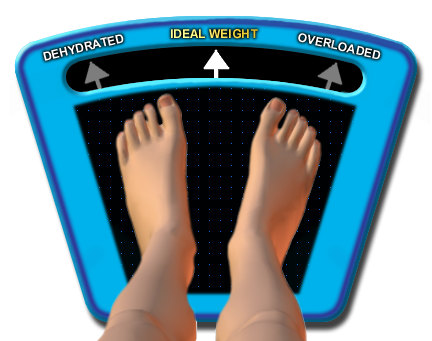Body weight
Body weight is a biometric feature and denotes the physical mass of a human (or animal), usually expressed in kg. It is shortly after the birth of the smallest and then takes to adulthood in normal development, together with the body size is steadily increasing.
Many people, especially in developing countries suffer from underweight because they have too little to eat. Overweight (or its more severe form obesity ) is a common problem that has increased in developing countries and in developed countries.
Also, eating disorders can cause underweight (eg anorexia and bulimia) or lead to obesity (eg, binge eating ).
Birth weight
The birth weight of the newborn is determined in many countries, recorded and analyzed statistically. There is a correlation between (over) weight of women in labor and (over ) weight of the newborn. Obesity in the womb make the birth more risky (from 4000 grams birth take risks a little, from 4500 grams clearly ) and can have lifelong problems for infants result.
Obese women more likely to suffer gestational diabetes. Then her blood contains too much sugar. Add the sugar saves the baby in a modified form in his organs. Although the children grow, they remain immature and often do not achieve the required performance.
The continuing flood of sugar also damages a mechanism, called " fetal programming". The control of food intake in the brain is impaired in this case; the children will not get enough.
Calculation formulas, indexes,
Body weight can be measured quickly and easily using a scale. A quantitative assessment of body weight in relation to body size is considered problematic. A number of indices have been developed to in the last 150 years.
Broca's index
The Broca's index is a measure for calculating the normal weight of a person. It was developed by Paul Broca, a French physician, surgeon and anthropologist ( 1824-1880 ).
The index defined on the basis of body size l (in cm) a normal weight m ( in kg) according to the formula:
In the second half of the 20th century was often considered even by an ideal weight of only 90 % for men and only 80 % for women of the value calculated above, but more for aesthetic than for medical reasons.
The Broca's index allows only a rough estimation and applies to the range of intermediate body sizes to best; at very large and very small body sizes of the BMI is more closely ( a limit observation can illustrate the Limitation: How much should a person with 1 m height Broca weigh Broca's ideal weight is at a very low height too low and too high for very large? ). Viewed graphically Broca's ideal weight is a straight line, the body mass index is a function of body size a slightly curved curve ( parabola).
Because particularities of each physique are ignored, both BMI and Broca's index are limited in their explanatory power; For example, a bodybuilder a very low body fat percentage, but due to its high muscle mass may have a BMI of well over 25
The advantage of the calculated Broca weights is that a metric -minded person can calculate in your head.
Example
For a 1.75 m tall man of Broca index provides Normal Weight 75 kg and as ideal weight (-10%) 67.5 kg. This corresponds to BMI values of 24.5 and 22, respectively, ie values within the normal weight range. For a 1.65 m tall woman Broca index provides Normal Weight 65 kg and as ideal weight (-20 %) 52 kg. This corresponds to BMI values of 24 or 19, so values within the normal weight range. From the age of 65 years will be added to 2.5 kg in men and women for the ideal weight.
The body mass index ( BMI for short ), sometimes called the German-speaking and body mass index or number, calculated from the body mass m (in kg) and height l (m ) an index according to the formula:
This is with - compared to standard values - depending on the source gender- or age-dependent.
As naturally at a measurement of body weight can not be distinguished between fat and muscle mass, the calculation of BMI is often associated with a measurement of body fat. Nominal overweight in combination with a low body fat percentage points rather to a muscular man because attention to the health risks associated fat. However, here also bear in mind that the burden of hip and knee joints and the lumbar spine is only determined by the weight, regardless of whether the weight comes from the shoulder and arm muscles or abdominal fat pads.
Ponderal index
The ponderal index is similar to the BMI. Its formula is:
Values 11 to 14 kg/m3 are assumed to be normal. This index is almost fulfilled the terms of a dimensionless measure of the similarity theory, as it is dimensional analysis applicable regardless of body size and therefore also for children and very tall people. The ponderal index is still not widespread.
Waist -hip ratio
The waist -hip ratio, also known as waist- hip ratio, ignoring the relationship between body weight and height and is based solely on the body shapes. Originally used primarily as an indicator of different health risks at the same BMI, the waist- hip ratio nowadays is also used as the sole indicator of obesity.
Waist circumference
As a further simplification of the waist -to-hip ratio is lately increased the pure waist circumference, regardless of body size, used as an indicator of obesity. Due to its simplicity, this method is now favored by doctors. Your shortcoming, however, is that previous studies almost exclusively on the BMI based and examination results can therefore be difficult to compare.
Normal weight, ideal weight
There is no medical consensus on what should be the normal weight to be designated as desirable or natural body weight of a human. It is even debatable whether there is such a value to be set at all. In this respect, there are several design formulas for determining the normal or ideal - and under-or overweight, which result in similar values in the result. Despite this debate about the correct value of a normal or ideal weight, there are clear ideas outside what weight range as a person ( morbidly ) is below or to assess overweight.
Depending on body size, gender and severity of bone structure - - body weights with the highest life expectancy determined and consider as the ideal weights, especially a large-scale study of U.S. life insurance companies from the 1950s, in which you became famous. The values were, for example, for a 180 cm tall man with moderately heavy bone 68 to 75 kg for an equally large woman 63 to 70 kg; for a 170 cm tall man 61 to 67 kg for an equally large woman 56 to 63 kg. With heavy bone, the values 3 kg were higher, with light 3 kg lower. Per 10 cm body size increased and the values reduced to 5-6 kg.
In addition to the usual methods of calculation also quantiles ( for Under / overweight) or the median ( for the ideal weight ) used empirically obtained distributions of body weight of a population group for evaluation.
A recent report by the WHO uses the BMI and defines normal weight with a BMI of 18.5-24.9.
Underweight
A recent report by the WHO uses the BMI and defines underweight with a BMI of less than 19.5.
Underweight leads to a deficient supply the body with protein, fats and carbohydrates as well as vitamins and minerals. The skin and hair changes, the bones decalcify and the muscles disappear. In addition, some institutions will continue their task no longer meet properly, because nutrients are missing.
Overweight
A recent report by the WHO uses the BMI and overweight defined as follows:
The health assessment of these limits, however, is not uniform in the professional world. Obesity is a risk factor for various diseases (eg heart attack, stroke, diabetes mellitus). Regular exercise and overeating (especially low in fat and low in carbohydrates ) can reduce the body weight.
Recent findings indicate that the mentioned values should be re-evaluated. Thus, a BMI of 25-30 is still " healthy " because people with mild to moderate overweight live longer on average. For some diseases could be a higher fat reserves can be beneficial (for example, surgery or serious infection ). What is referred to as overweight / pre-obese is statistically the ideal weight, as it is the weight with the highest life expectancy. For example, according to an Israeli long-term study of 10,000 men aged over 40 years, men are slightly overweight (BMI 25-27 ) significantly better prospects of longevity than people of normal weight. In severe overweight (BMI > 27), the life expectancy falls again.
Two recent publications ( Ingrid Mühlhauser, University of Hamburg and a study from Oxford University ) in which a large number of studies and meta-analyzes were compared and evaluated, show that a slight predominance for the susceptibility to some diseases is a disadvantage for other beneficial. It is for example very much depends on where the body fat is stored. Is this in the abdomen ( " apple-shaped " figure), as this increases the risk of cardiovascular disease and diabetes. Fat on butt and thighs ( " pear-shaped " figure) can protect against these diseases just. However, according to current knowledge, the fat distribution is genetically determined and can not be influenced, and the risk of arthritis of the joints of the lower extremities is increased by the weight regardless of the fat distribution. The publications mentioned remained in the professional world also contradicted in any way.









